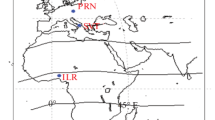Abstract
Based on the ionosphere observation data obtained by EISCAT Svalbard Radar (ESR) in solar minimum year — 2007, we analyzed diurnal variations of F2-peak electron density (NmF2) in four seasons under disturbed and quiet geomagnetic conditions. It indicated that the soft precipitation electron had an evident effect on the NmF2 increase at magnetic noon in spring, summer and autumn and the electron precipitation effects were prominent in winter. The comparison between the IRI-2007 model and the observation exhibited that the IRI (International Reference Ionosphere) model had a better NmF2 prediction when the photoionization was dominant during the polar day, but worse when the electron precipitation was dominant during the polar night. We showed that the electrons in lower energy band decreased when the geomagnetic disturbance went greater, which resulted in the lower NmF2. By analyzing the spectrum of precipitation electron under different geomagnetic conditions, it was found that this phenomenon was induced by the energy flux enhancement of precipitation electron of low energy.
Similar content being viewed by others
References
Bilitza D. International Reference Ionosphere 2000. Radio Sci, 2001, 36: 261–275
Bilitza D, Reinisch B W. International Reference Ionosphere 2007: Improvements and new parameters. Adv Space Res, 2008, 42: 599–609
Liu H, Claudia S, Shigeto W, et al. Evaluation of the IRI model using CHAMP observations in polar and equatorial regions. Adv Space Res, 2007, 39: 904–909
Reigber C, Lühr H, Schwintzer H. CHAMP mission status. Adv Space Res, 2002, 30: 129–134
Moen J, Qiu X C, Carlson H C, et al. On the diurnal variability in F2-region plasma density above the EISCAT Svalbard radar. Ann Geophys, 2008, 26: 2427–2433
Zhang S R, Holt J, Bilitza D, et al. Multiple-site comparisons between models of incoherent scatter radar and IRI. Adv Space Res, 2007, 39: 910–917
Lei J H, Liu L B, Wan W X, et al. Comparison of the first long-duration IS experiment measurements over Millstone Hill and EISCAT Svalbard radar with IRI2001. Adv Space Res, 2006, 37: 1102–1107
Cai H T, Ma S Y, Schlegel K. Climatologic characteristics of high-latitude ionosphere-EISCAT observations and comparison with the IRI model (in Chinese). Chin J Geophys, 2005, 48: 471–479
Liu Y C, Ma S Y, Cai H T. The background ionospheric profiles at polar cusp latitudes — ESR observations (in Chinese). Chin J Polar Res, 2005, 17: 193–202
Liou K, Newell P T, Meng C I, et al. Synoptic auroral distribution: A survey using Polar ultraviolet imagery. J Geophys Res, 1997, 102: 27197–27206
Perevalova N P, Polyakova A S, Zalizovski A V. Diurnal variations of the total electron content under quiet helio-geomagnetic conditions. J Atoms Solar-Terr Phys, 2010, 72: 997–1007
Kohl H, King J W. Atmospheric winds between 100 and 700 km and their effects on the ionosphere. J Atmos Terr Phys, 1967, 29: 1045–1062
Spiro R W, Reiff P H, Maher L J Jr. Precipitating electron energy flux and auroral zone conductances: An empirical model. J Geophys Res, 1982, 87: 8215–8227
Hardy D A, Gussenhoven M S, Holeman E. A statistical model of the auroral electron precipitation. J Geophys Res, 1985, 90: 4229–4248
Meier R R, Strickland D J, Hecht J H, et al. Deducing composition and incident electron spectra from ground-based auroral optical measurements: A study of auroral red line processes. J Geophys Res, 1989, 94: 13541–13552
Liu J M, Zhang B C, Liu R Y, et al. Effects of the precipitation electrons on the polar ionosphere with different energy spectrum (in Chinese). Chin J Geophys, 2009, 52: 1429–1437
Rees M H. Auroral ionization and excitation by incident energetic electrons. Planet Space Sci, 1963, 11: 1209–1218
Author information
Authors and Affiliations
Corresponding author
Rights and permissions
About this article
Cite this article
He, F., Zhang, B. & Huang, D. Averaged NmF2 of cusp-latitude ionosphere in northern hemisphere for solar minimum — Comparison between modeling and ESR during IPY. Sci. China Technol. Sci. 55, 1281–1286 (2012). https://doi.org/10.1007/s11431-012-4782-0
Received:
Accepted:
Published:
Issue Date:
DOI: https://doi.org/10.1007/s11431-012-4782-0




